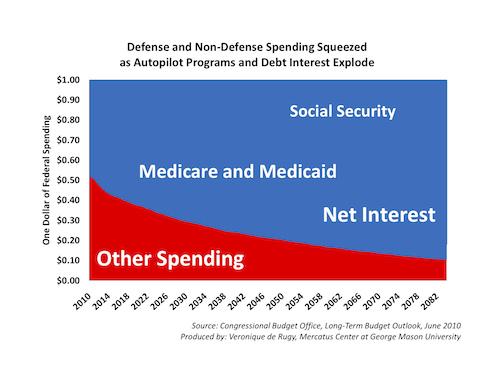- | Government Spending Government Spending
- | Data Visualizations Data Visualizations
- |
Defense and Non-Defense Spending Programs Squeezed as Autopilot Programs and Debt Interest Explode
This chart plots the projected change in the composition of federal spending from 2010 to 2084; the proportion of federal spending under lawmakers’ control collapses over time.
This chart by Mercatus Center Senior Research Fellow Veronique de Rugy plots the projected composition of federal spending from 2010 to 2084 using data from the Congressional Budget Office’s most recent Long-Term Budget and Economic Outlook.
The costs of the largest mandatory spending programs and interest on the debt are plotted in blue; all other spending is shown in red. Conservatively, these projections assume that interest rates on the debt will remain low. These components of federal spending matter not only because of their magnitude, but also because they are automatic in nature.
Put differently, spending in these areas will automatically increase, simply from lawmakers’ inaction. If lawmakers leave current mandatory spending laws unchanged, federal spending will mechanically increase, pushing the level of federal spending further and further away from the historical level of taxation.
As a result of this automatic spending, we will face two major consequences: first, smaller portions of federal spending will be under lawmakers’ functional control and second, we will face gargantuan deficits into the foreseeable future, which will have significant negative impact on economic growth. Viewing the data this way makes the reality clear - the proportion of federal spending under lawmakers’ control is projected to collapse over time.
According to the Congressional Budget Office, this year $0.48 of every dollar of federal spending will be devoted to Social Security, Medicare and Medicaid, and net interest spending. By 2084, $0.90 of every dollar the federal government spends will go to these auto piloted mandatory programs and to interest payments on the debt. This means that $0.10 of every dollar of federal spending will be available to fund everything else. With less spending under lawmakers’ discretion, less is available to address education, defense, poverty reduction, emergencies, and any other function of the federal government.


